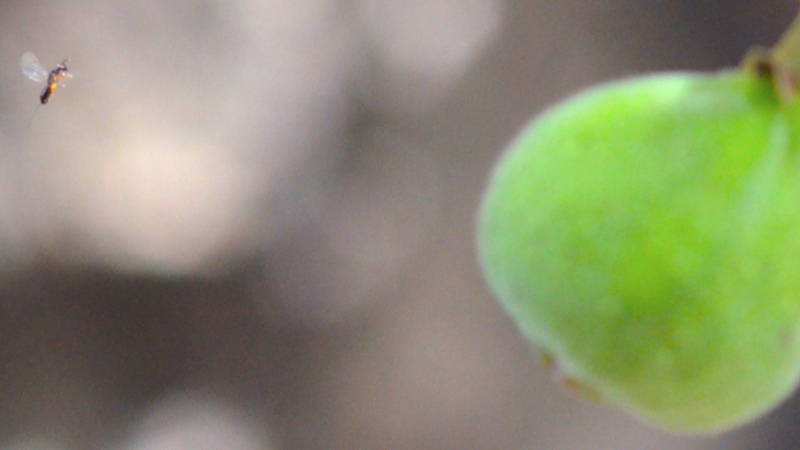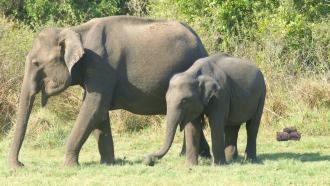
Roald Dahl’s famous book ‘James and the Giant Peach’ is a story of a boy named James, who, to escape his cruel aunts, takes up residence inside a giant, magical peach. Inside this fruit, he ends up having many wonderful adventures with a grasshopper, a centipede, an earthworm, a spider, a ladybug, and a glowworm -- all of them living inside the same peach! While one may dismiss this as a fantasy or a ‘bedtime’ story, many young fig wasps live a life of James, albeit inside a fig!
In a recent study, published in the journal Movement Ecology, researchers at the Indian Institute of Science, Bengaluru, have uncovered some hitherto unknown, exciting aspects about fig-wasps and the journey they take to lay their eggs. “Fig wasp communities are fantastic for a lot of reasons, especially since they are in such a close and intimate association with their host plant,” says Vignesh Venkateswaran, the lead author of the study.
Pollinating fig wasps and fig trees share an extraordinary special relationship where both benefit from each other. The female pollinating wasps enter the syconia – the inflorescence of the fig, pollinate and lay their eggs in the syconia. Once done, their offspring develop and upon reaching adulthood, fly out with pollen clinging to them to repeat the cycle. When these wasps enter another syconium, they pollinate them. Fig wasp communities also consist of non-pollinating wasp species.This study investigated a community of seven wasp species of which only one species pollinates the fig.. The other six species are essentially cheaters in the system; making use of the fig to lay eggs without offering any service in return. And as for the eggs, they safely hatch and grow into adults, feeding on the fig, away from the eyes of their predators. This relationship can get so specific that the wasps of a specific species will only lay eggs in a syconium which is in precisely the right stage of development.
Apart from the obligate relationship, another fascinating aspect of fig wasps is the journey they take from their ‘home’ tree where they reside (natal tree) to the trees where they lay their eggs (resource tree). Though we know that each species of the fig wasp has its own window of time to lay its eggs, called an oviposition window, not much is known about the journey yet -- an aspect the researchers of the study are trying to bring out. “These trees can be away from each other by as much as 100 km or more, and these 2mm wasps have to fly such long distances in very short times, to survive and reproduce. Though fig wasps are expected to be excellent at flying and dispersing long distances, no study has ever attempted to characterise their ability to move,” shares Vignesh Venkateswaran.
The primary constraint in the journey of female wasps is the very short window in which they have to lay their eggs. Since all figs in their natal tree, where they are born, are in the same developmental stage and ripen once the adult wasps are released, the wasps now need to look for younger syconia to lay their eggs. “Wasps have to fly away to find other trees. But since each wasp is looking for a fig in a particular developmental stage, they are searching for different trees,” points out Vignesh.
Previous studies have shown that wind disperses female wasps from their natal syconium. In fact, the wasp species Ceratosolen arabicus can be wind-scattered over 160 km in its one-day adult lifespan! In this arduous journey, what role do wasps play in channelising their movement? The researchers tested the flight duration, energy reserves and resting metabolic rates of seven wasp species – five short-lived species and two with longer lifespans – to decipher this.
“Each species has a specific oviposition window length. Imagine a wasp that has an oviposition window of only two days and another which has an oviposition window of 16 days. For the first wasp, the figs last for a short period in that stage. This short window would mean that there are fewer trees that have that stage of fig; fig trees transition through this stage quickly. On the other hand, for a wasp that has an oviposition window of 16 days, the figs last for a very long time serving as a resource. The wasp can, during any of the 16 days, lay its eggs. In simple terms, there will be eight times as many trees in any instance for the second wasp, compared to the first”, explains Vignesh Venkateswaran.
The researchers found that all three traits – flight duration, energy reserves and resting metabolic rates – were higher in short-lived species as compared to the long-lived ones. This finding is significant as wasps with a short lifespan, generally tend to have smaller windows of opportunity to lay eggs and hence, need to traverse longer distances in search of syconia in the right stage of development. The study demonstrates, for the first time, that the developmental stage of the syconium influences the insect’s dispersal capacities. The results of the investigation also suggests that these traits are inherited across generations and strengthened by natural selection.
The study gives a new perspective on what could lead to differences in movement abilities of each species of a single community, and what could be the evolutionary forces that make them move the way they do. Besides, studies on these tiny wasps help throw some light into the fragile lives of figs and fig wasps. “Figs are important life-lines for animals in tropical forests. Each kind of fig has its own unique wasp community. The future of both is uncertain now due to rapid deforestation,” remarks Vignesh.
The researchers now plan to understand this complicated process of fig wasp movements with more hypotheses and modelling. “We are investigating dispersal of multiple fig wasp communities and testing some of our hypotheses. We are also modelling the minimum number of trees that may be required to enable the persistence of wasp communities,” signs off Vignesh Venkateswaran.






